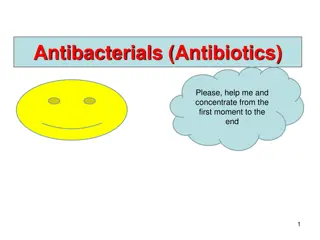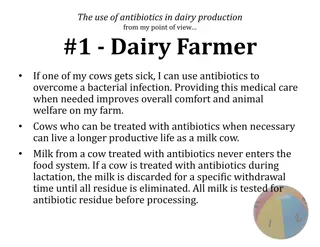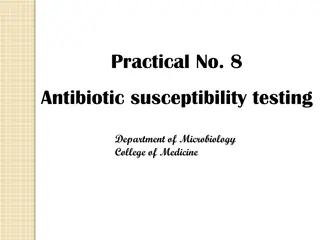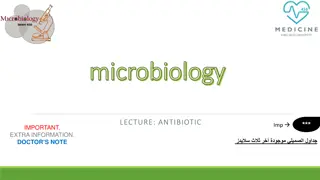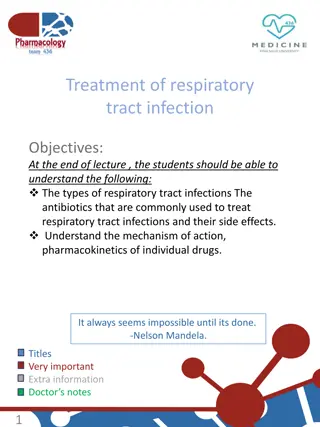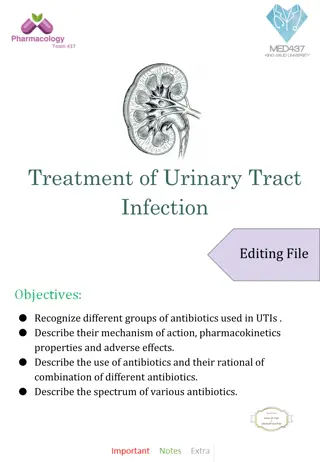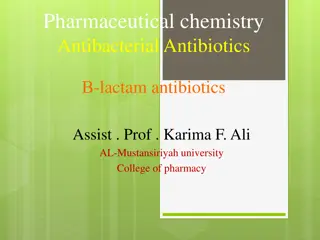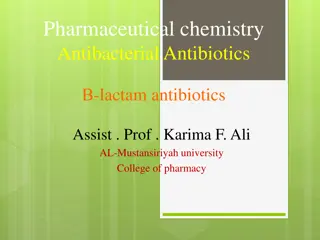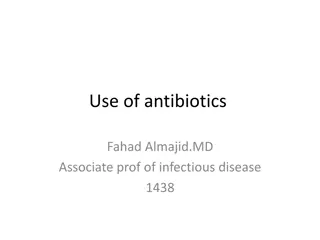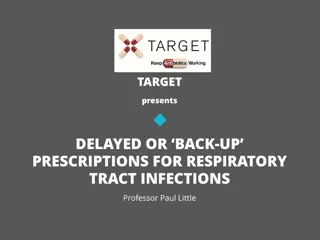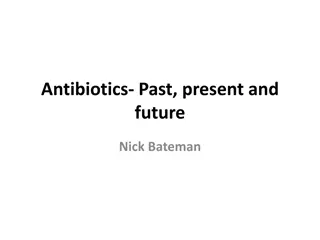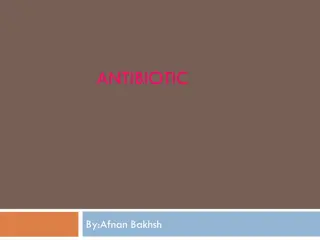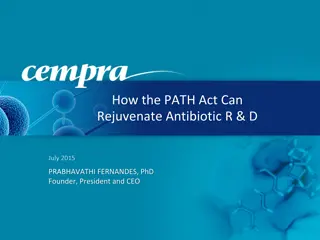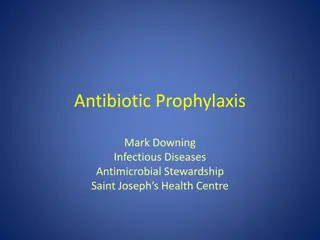
Antibiotics and Antimicrobial Agents in Infections
Learn about antibiotics and antimicrobial agents that fight against infections, including tips for accurate diagnosis, therapy, pharmacodynamics, and identifying infection sites. Find out when antibiotics are indicated and how to handle urgent situations like meningitis and septic shock.
Download Presentation

Please find below an Image/Link to download the presentation.
The content on the website is provided AS IS for your information and personal use only. It may not be sold, licensed, or shared on other websites without obtaining consent from the author. If you encounter any issues during the download, it is possible that the publisher has removed the file from their server.
You are allowed to download the files provided on this website for personal or commercial use, subject to the condition that they are used lawfully. All files are the property of their respective owners.
The content on the website is provided AS IS for your information and personal use only. It may not be sold, licensed, or shared on other websites without obtaining consent from the author.
E N D
Presentation Transcript
Antibiotic: Chemical produced by a microorganism that kills or inhibits the growth of another microorganism Antimicrobial agent: Chemical that kills or inhibits the growth of microorganisms
1) Obtain accurate diagnosis of infection. 2) Empiric and definitive therapy. 3) Identifying opportunities to switch to narrow-spectrum. 4) Cost-effective oral agents for the shortest duration necessary.
5) Understanding drug pharmacodynamics and efficacy at the site of infection.. 6) Host characteristics that influence antimicrobial activity 7) Adverse effects of antimicrobial agents on the host.
Determining the site of infection, Defining the host (e.g., immunocompromised) Establishing, when possible, a microbiological diagnosis. especially for: Endocarditis, septic arthritis, meningitis.. Endocarditis, septic arthritis, meningitis.. Additional investigations to exclude noninfectious diagnoses
Microbiological diagnosis : Bacterial or fungal culture or Serologic testing.. Frequently the Most likely microbiological etiology can be inferred from the clinical presentation: Most likely Cellulitis (streptococci or staphylococci ) No need for positive culture. Cellulitis
Is An Antibiotic Indicated? Clinical diagnosis of bacterial infection. Pneumonia (CAP) can also be treated empirically Macrolide or fluoroquinolone antibiotic without performing specific diagnostic test Pneumonia
Urgent situation: 1) Acute meningitis 2) Septic shock 3) Febrile neutropenia.. Empiric therapy should be initiated immediately after or concurrently with collection of diagnostic specimens Urgent situation: Empiric therapy should be initiated immediately after or concurrently with collection of diagnostic specimens. None urgent 1) febrile and stable patient with fever for several days with no clue to diagnosis.. None urgent:
In more stable clinical circumstances.. In more stable clinical circumstances.. Hold antibiotics until appropriate specimens have been collected and submitted: Hold antibiotics until appropriate specimens have been collected and submitted: Example: Example: subacute cultures subacute bacterial endocarditis . multiple sets of blood cultures bacterial endocarditis . multiple sets of blood
16 year old boy who presented with 3 days H/O high grade fever and severe headache ..examination revealed T: 39 and patient has neck stiffness, otherwise fully conscious and has no neurological deficit : What is the most appropriate steps of approach: A) Start combination of antibiotic and arrange for CSF study. B) Arrange for urgent CT-scan brain , C) Perform urgent LP and give the first dose of antibiotics. D) perform urgent LP and if csf is abnormal ,start RX A OR C
Patient was prescribed a dose of : cefetriaxone and vanocmycin and urgent LP is done: Result: WBC : 1230 cells/mm 90% polymorph.. RBC : NIL .. Gram stain: Gram positive intracellular dipplococci What you will do? To continue the same antibiotics? Yes or No. Gram positive intracellular dipplococci.. Yes or No.
Premature initiation of antimicrobial therapyany harm ? 1] can suppress bacterial growth 2] Preclude the opportunity to establish a microbiological diagnosis, 3] Require several weeks of directed antimicrobial therapy to achieve cure.
Microbiological results do not become available for 24 to 72 hours Empiric and guided by the clinical presentation.. Inadequate therapy for infections in critically ill, hospitalized patients is associated with greater morbidity and mortality Use broad-spectrum antimicrobial agents as initial empiric therapy
What organisms are likely to be responsible : Best Educated Guess? Based on: Hx & P.E . You might have a clue to DX. Epidemiological data Hospital-acquired vs. community-acquired Prior antibiotic use
Best Educated Guess? Patient with dyspnoea and cough .. Streptococcal pneumonia and atypical organism.. Streptococcal pneumonia and atypical organism.. Patient with fever and urinary E.coli Patient with fever and urinary symptomes E.coli symptomes : : . . Patient with with pain and tenderness Group A Streptococcus and Staphylococcus Patient with erythema with pain and tenderness Group A Streptococcus and Staphylococcus erythema over the right leg associated over the right leg associated
Hospital Related to the presence of invasive devices Hospital- -acquired infections acquired infections invasive devices and procedures procedures A] Catherter Coagulase Methicillin Catherter related Coagulase negative staph Methicillin- -resistant Staphylococcus related bacteremia negative staph.. resistant Staphylococcus aureus bacteremia:, aureus [MRSA] [MRSA] B] Catheter related UTI Gram negative ( Catheter related UTI: Gram negative (eg eg, Pseudomonas , Pseudomonas aeruginosa aeruginosa) )
Once : 1) Microbiology have identified the etiologic pathogen and 2) Antimicrobial susceptibility data are available.. Then Every attempt should be made to narrow the antibiotic spectrum Every attempt should be made to narrow the antibiotic spectrum. : 1) It can reduce cost and toxicity and 2) Prevent the emergence of antimicrobial resistance in the community
Antimicrobial susceptibility testing measures the ability of a specific organism to grow in the presence of a particular drug in vitro: susceptible, resistant, or intermediate susceptible, resistant, or intermediate Data are reported in the form of minimum inhibitory concentration (MIC): The lowest concentration of an antibiotic that inhibits visible growth of a microorganism..
Susceptible indicates that the isolate is likely to be inhibited by the usually achievable concentration of a particular antimicrobial agent when the recommended dosage is used.. Different antibiotics has different MIC. Susceptible:
23 years old man who has surgery at the base of the skull After trauma . Presented few days later with meningitis CSF has revealed : WBC 1200 mainly poly Culture : staph aureus .. RX cephazolin.. it does not achieve therapeutic concentrations in the CSF
Bactericidal Cause death and disruption of the bacterial cell. Drugs act on : 1) The cell wall . -lactams 2) Cell membrane .. Daptomycin 3) Bacterial DNA . Fluoroquinolones Preferred in the case of serious infections such as endocarditis & meningitis to achieve rapid cure
Bacteriostatic Inhibit bacterial replication without killing the organism. act by inhibiting protein synthesis: SUCH AS : Bacteriostatic Sulfonamides. Tetracyclines. Macrolides.
Exhibits synergistic activity is used in the treatment of serious Infections: A] Rapid killing is essential Endocarditis caused by Enterococcus a combination of penicillin and gentamicin activity Rapid killing is essential Enterococcus species penicillin and gentamicin: bactericidal species with bactericidal, B] shorten the course: Endocarditis due to viridans group streptococci, penicillin or ceftriaxone with gentamicin for 2 weeks can be as effective as penicillin or ceftriaxone alone for 4 weeks). shorten the course:
D] Antimicrobial combinations, such as a third-generation cephalosporin or a fluoroquinolone plus D] Polymicrobial Infections: Polymicrobial Infections: plus metronidazole,
Synergism Antagonism Indifference Log of number if viable bacteria/mL No drug No drug No drug Drug A Drug A Drug C Drug B Drug B A + C A + B I I III I A + B Drug A Hours after inoculation
1) Renal and Hepatic Function.. 2) Pregnancy and Lactation Special considerations .. teratogenicity or otherwise toxic to the fetus. : Sulphonamides preterm infants.. Sulphonamides : A risk to develop kernicterus, especially Tetracycline Fluoroquinolone Tetracycline : Staining of the teeth.. Fluoroquinolone: Cartilage damage to the fetus.. 3) History of Allergy or Intolerance. Pencillin and anaphylaxis
Consider Special Host Factors Genetic e.g. G6PD Renal function Liver function Pregnancy & Lactation Drug interaction
Phacomelia Thalidomide was released in the late 1950's It was very effective : anti emetic and used to treat morning sickness and emesis in pregnant women.. Phacomelia.. The biggest man made medical disaster ever, Over 10,000 children were born with a range of severe and debilitating malformations
Candidates for treatment mild to moderate infections well-absorbed oral antimicrobial agents : A] Pyelonephritis Fluoroquinolones Pyelonephritis Fluoroquinolones .. .. B] Community-acquired pneumonia Augmentin and macrolides coverage Augmentin and macrolides coverage
Bioavailability Bioavailability The percentage of the oral dose that is available unchanged in the serum). The percentage of the oral dose that is available unchanged in the serum). Examples of antibiotics with excellent bioavailability are: Trimethoprim . Trimethoprim- -sulfamethoxazole sulfamethoxazole
The efficacy of antimicrobial agents depends on their capacity to achieve : Ocular fluid, CSF, abscess cavity, prostate, and bone) are often much lower than serum levels For example: First- and second- generation cephalosporins do not cross the blood-brain barrier Concentration equal to or greater than the MIC at the site of infection.. Concentration equal to or greater than the MIC at the site of infection..
Aminoglycosides low-oxygen, low-pH, of Abscesses Aminoglycosides: : are less active are less active in the : of Abscesses Fluoroquinolones preferred oral agents for the treatment of Prostatitis Fluoroquinolones achieve high concentrations in the prostate Prostatitis.. .. Moxifloxacin therefore not suitable Moxifloxacin does not achieve significant urinary concentrations not suitable for treatment of UTIs. UTIs.
Response to treatment of an infection: Clinical parameters improvement of symptoms and signs (eg, fever, tachycardia, or confusion fever, tachycardia, or confusion laboratory values decreasing leukocyte count radiologic decrease in the size of an abscess).,
1 1) Presurgical Antimicrobial Prophylaxis is used to reduce the incidence of postoperative surgical site infections.. ) Presurgical Antimicrobial Prophylaxis A single dose of a cephalosporin (such as cefazolin) administered within 1 hour before the initial incision is appropriate for most surgical procedures..
2 2) ciprofloxacin ) Prevent Transmission of Communicable Pathogens to Susceptible Contacts ciprofloxacin for close contacts of a patient with N.meningitis Prevent Transmission of Communicable Pathogens to Susceptible Contacts 3 3) ) Antimicrobial Prophylaxis Before Dental Procedures: : Prosthetic valves Rheumatic heart.. to prevents Endocaridits
Examples : Adult onset Still disease Adult onset Still disease Drug Drug- -induced fever induced fever fever associated with pulmonary embolism fever associated with pulmonary embolism lymphoma lymphoma
Colonization of disease occurs frequently in certain populations: Colonization without any associated manifestation Colonization of : Old women with indwelling urinary catheter: Active infection are absent (asymptomatic bacteriuria) Active infection are absent (asymptomatic bacteriuria) Endotracheal tubes in mechanically ventilated patients, chronic wounds..
Appropriate use of antimicrobial agents involves: Obtaining an accurate diagnosis, Obtaining an accurate diagnosis, Determining the need for and timing of antimicrobial therapy. Understanding how dosing affects the antimicrobial activities of different agents, Determining the need for and timing of antimicrobial therapy. Understanding how dosing affects the antimicrobial activities of different agents, Tailoring treatment to host characteristics, Tailoring treatment to host characteristics,
Sign for the narrowest spectrum and shortest duration of therapy, and: switching to oral agents as soon as possible. In addition, Nonantimicrobial interventions, such as abscess drainage, are equally or more important in some cases and should be pursued diligently in comprehensive infectious disease management.
The lowest dose that is effective The lowest dose that is effective.. AVOID SUB-THERAPEUTIC DOSES DETERMINED BY: SERIOUS VS NON-SERIOUS INFECTIONS SITE OF INFECTION DRUG PK/PD PROPERTIES OTHER HOST FACTORS (E.G. RENAL FUNCTION ETC)
Principles: Narrow vs broad spectrum agents. Least toxic agent. Cheaper.
Antimicrobial activity is superior Have a therapeutic advantage Better pharmacokinetics Site penetration Longer t Shorter duration Less toxic Better tolerance


